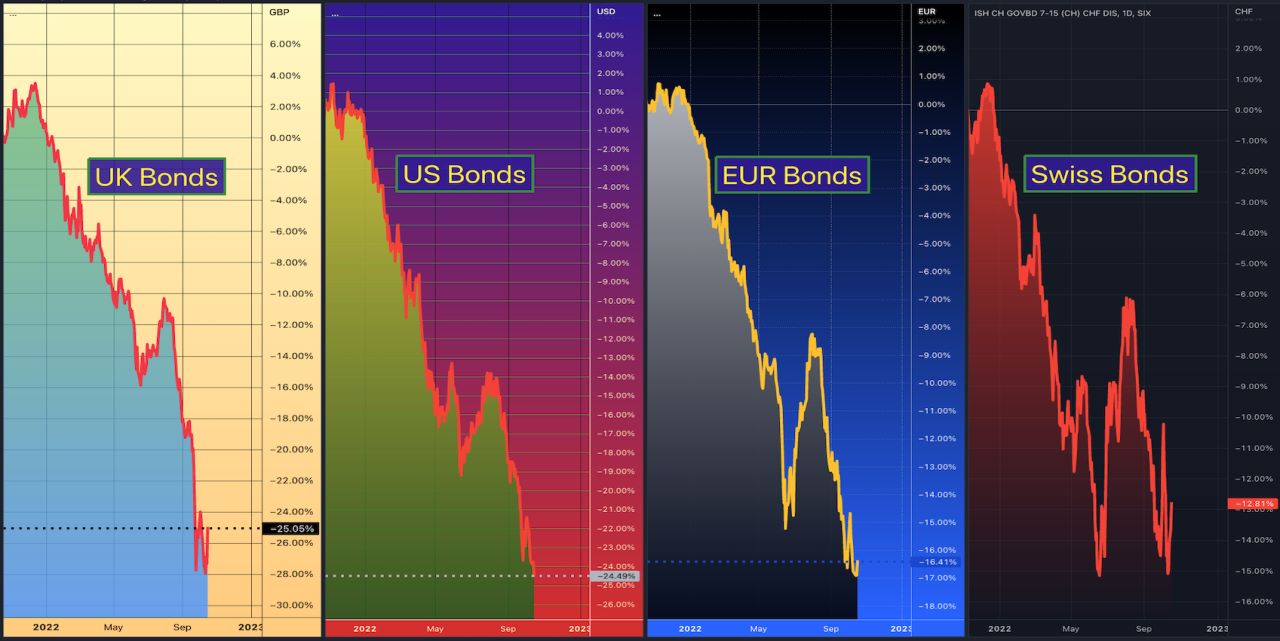

Finance
Where Are CA Pension Funds Held?
Published: January 22, 2024
Discover where California pension funds are held and managed. Learn about the finance strategies and institutions involved in overseeing these funds.
(Many of the links in this article redirect to a specific reviewed product. Your purchase of these products through affiliate links helps to generate commission for LiveWell, at no extra cost. Learn more)
Table of Contents
**
Introduction
**
California's pension funds play a crucial role in securing the financial future of millions of public employees. These funds are managed by various entities and are instrumental in providing retirement benefits to teachers, firefighters, police officers, and other public servants. Understanding where these funds are held and how they are invested is essential for both the beneficiaries and the general public.
California's pension system is not only one of the largest in the United States but also one of the most complex. With a diverse portfolio of investments, including stocks, bonds, real estate, and private equity, the management of these funds requires a high level of expertise and oversight. The decisions made regarding these investments can have far-reaching implications for the financial well-being of retirees and the overall stability of the funds.
In this article, we will delve into the intricacies of California's pension funds, exploring the types of investments they hold, major investment holdings, and the challenges and controversies surrounding these funds. By gaining insight into the management and allocation of these funds, readers will develop a deeper understanding of the mechanisms that underpin the state's pension system and the potential impact on both retirees and taxpayers.
**
Overview of California Pension Funds
**
California’s pension funds represent a cornerstone of the state’s financial infrastructure, providing retirement security for public employees. The two largest pension funds in California are the California Public Employees’ Retirement System (CalPERS) and the California State Teachers’ Retirement System (CalSTRS). CalPERS serves public employees, retirees, and their families, while CalSTRS caters to the state’s educators.
These pension funds are designed to ensure that public employees receive adequate retirement benefits, thereby attracting and retaining a skilled workforce. The funds are financed through contributions from both employees and participating government entities, with investment returns also playing a significant role in sustaining the funds’ long-term viability.
CalPERS, as the largest public pension fund in the United States, administers retirement and health benefits for more than 2 million public employees. Its investment portfolio spans a diverse range of asset classes, including domestic and international equities, fixed income, real estate, private equity, and infrastructure. Similarly, CalSTRS manages the retirement benefits of over 1 million educators and has a substantial investment portfolio aimed at generating returns to support pension obligations.
The governance and management of these pension funds are overseen by boards of directors and investment committees, which are responsible for setting investment policies, selecting investment managers, and monitoring the performance of the funds. These entities are guided by fiduciary duties to act in the best interests of the beneficiaries and to prudently manage the funds to ensure their long-term sustainability.
Understanding the structure and operation of California’s pension funds is vital for public employees, retirees, taxpayers, and policymakers. The financial health of these funds directly impacts the state’s budget, the ability to meet pension obligations, and the overall stability of the retirement system. As such, ongoing scrutiny and informed discourse regarding the management and investment strategies of these funds are essential for maintaining their integrity and fulfilling their obligations to current and future retirees.
**
Types of Investments in California Pension Funds
**
California’s pension funds deploy a diverse array of investment strategies to generate returns and sustain the long-term financial health of the funds. These investment approaches encompass various asset classes, each with its unique risk-return profile and contribution to the overall portfolio performance.
Equities: Both CalPERS and CalSTRS allocate a significant portion of their portfolios to domestic and international equities. Equities, or stocks, represent ownership stakes in publicly traded companies and offer the potential for capital appreciation and dividend income. While equities can be volatile in the short term, they have historically delivered strong returns over the long term, making them a core component of pension fund investments.
Fixed Income: Fixed income securities, including government and corporate bonds, are another key investment category for California’s pension funds. These instruments provide regular interest payments and return of principal upon maturity, offering income stability and capital preservation within the overall portfolio. Fixed income investments serve to balance the risk of equities and provide a source of steady cash flow for the funds.
Real Estate: Both CalPERS and CalSTRS have substantial allocations to real estate investments, including commercial properties, residential developments, and infrastructure projects. Real estate holdings offer the potential for rental income, property appreciation, and portfolio diversification, contributing to the overall stability and returns of the pension funds.
Private Equity: California pension funds also invest in private equity, which involves taking ownership stakes in private companies with the aim of enhancing their value over time. Private equity investments are typically illiquid but have the potential to deliver substantial returns, albeit with higher risk and longer investment horizons.
Infrastructure: Infrastructure investments, such as toll roads, airports, and utilities, form a part of the pension funds’ alternative asset allocations. These long-term, income-generating assets can provide inflation-protected returns and diversification benefits, bolstering the resilience of the funds’ overall investment portfolio.
Understanding the composition of these investment categories is crucial for stakeholders and the public at large, as it underscores the prudent diversification and risk management practices employed by California’s pension funds. By strategically allocating capital across a spectrum of asset classes, the funds aim to optimize returns while mitigating risk, ultimately safeguarding the retirement benefits of public employees and contributing to the state’s fiscal stability.
**
Major Investment Holdings
**
California’s pension funds, namely CalPERS and CalSTRS, maintain substantial holdings across a spectrum of investments, reflecting their diversified approach to portfolio management. These major investment holdings encompass publicly traded securities, real assets, and private market investments, contributing to the funds’ overall performance and long-term sustainability.
Equities: The pension funds’ equity holdings span a wide range of publicly traded companies, both in the United States and internationally. These holdings include blue-chip stocks, growth-oriented firms, and value-driven enterprises across various sectors such as technology, healthcare, consumer goods, and financial services. The equity component of the funds’ portfolios is designed to capture capital appreciation and dividend income while participating in the growth potential of global markets.
Fixed Income: Within the fixed income segment, the pension funds hold a diverse array of government, municipal, and corporate bonds, providing income stability and capital preservation. These holdings are carefully selected to balance risk and return, aiming to deliver consistent cash flows while mitigating the impact of market volatility on the overall portfolio.
Real Estate: Both CalPERS and CalSTRS maintain extensive real estate holdings, encompassing commercial properties, residential developments, and infrastructure projects. These holdings provide exposure to income-generating properties, property appreciation, and diversification benefits within the funds’ investment mix. The real estate component contributes to the funds’ overall performance and serves as a hedge against inflation and market fluctuations.
Private Equity: The pension funds’ private equity holdings consist of investments in privately held companies across various industries and stages of development. These holdings are characterized by their illiquid nature and long-term investment horizon, with the potential to deliver substantial returns through operational improvements, strategic initiatives, and value creation within the private market arena.
Infrastructure: Infrastructure investments form a significant part of the pension funds’ alternative asset allocations, encompassing essential infrastructure assets such as transportation, energy, and utilities. These long-term, income-generating investments provide stable cash flows, inflation protection, and portfolio diversification, contributing to the funds’ overall resilience and performance.
By understanding the major investment holdings of California’s pension funds, stakeholders and the public gain insight into the funds’ asset allocation strategies, risk management practices, and the potential impact on the funds’ long-term financial sustainability. These holdings reflect the funds’ commitment to prudent diversification, capital appreciation, and income generation, aligning with their fiduciary duty to secure retirement benefits for public employees and retirees.
**
Challenges and Controversies
**
While California’s pension funds play a critical role in providing retirement security for public employees, they are not without challenges and controversies. These issues have sparked debates, legal battles, and calls for reform, shaping the discourse around the management and sustainability of the state’s pension system.
Underfunding: One of the primary challenges facing California’s pension funds is underfunding, where the projected future obligations exceed the current assets available to meet those obligations. This imbalance has raised concerns about the long-term financial health of the funds and the potential burden on taxpayers to bridge the funding gap.
Investment Performance: The investment performance of the pension funds has been a subject of scrutiny, particularly during periods of market volatility and underperformance. Critics have raised questions about the funds’ investment strategies, fees paid to external investment managers, and the ability to meet long-term return targets in a low-interest-rate environment.
Governance and Transparency: Governance and transparency issues have also surfaced, with calls for greater accountability, disclosure, and oversight of the pension funds’ decision-making processes. Stakeholders have emphasized the importance of robust governance structures, ethical conduct, and transparency in investment activities to uphold the fiduciary responsibilities owed to the beneficiaries.
Political and Legal Challenges: The intersection of pension funds with political and legal dynamics has led to controversies surrounding governance appointments, conflicts of interest, and legal disputes over pension reform initiatives. These challenges have underscored the complex interplay between public policy, legal frameworks, and the management of pension assets.
Sustainability and Reform: The sustainability of California’s pension system has been a focal point, spurring discussions on reform measures aimed at ensuring the long-term viability of the funds. Proposals for adjusting contribution levels, revising benefit structures, and exploring alternative investment approaches have been put forth to address the evolving landscape of pension obligations and funding dynamics.
Addressing these challenges and controversies requires a multifaceted approach that balances the interests of public employees, retirees, taxpayers, and the broader community. By fostering constructive dialogue, informed decision-making, and proactive governance, California’s pension funds can navigate these challenges while upholding their commitment to securing retirement benefits and preserving the financial integrity of the pension system.
**
Conclusion
**
California’s pension funds stand as pillars of financial security, serving the dedicated public servants who contribute to the state’s well-being. The intricate web of investments, governance structures, and challenges surrounding these funds underscores their critical importance and the need for informed stewardship.
As the custodians of retirement benefits for millions of public employees and educators, the California Public Employees’ Retirement System (CalPERS) and the California State Teachers’ Retirement System (CalSTRS) shoulder the responsibility of prudently managing vast portfolios to secure long-term financial sustainability.
By delving into the types of investments, major holdings, and the complexities of governance, stakeholders gain a deeper understanding of the mechanisms underpinning these funds. Equities, fixed income, real estate, private equity, and infrastructure investments collectively form a diversified tapestry aimed at optimizing returns while mitigating risk.
Despite the challenges and controversies that have emerged, including underfunding, investment performance, governance issues, and legal dynamics, the commitment to safeguarding retirement benefits remains paramount. The ongoing discourse surrounding sustainability and reform reflects a collective endeavor to ensure the resilience and integrity of the pension system.
Looking ahead, the continued scrutiny, dialogue, and proactive governance will be instrumental in navigating the complexities of pension fund management. By upholding fiduciary duties, enhancing transparency, and embracing prudent investment practices, California’s pension funds can fulfill their mandate, providing retirees with the financial security they deserve.
Ultimately, the enduring mission of California’s pension funds is to honor the dedication and service of public employees by securing their retirement futures. Through thoughtful management, strategic investment allocation, and responsive governance, these funds can continue to serve as cornerstones of financial stability, enriching the lives of those who have dedicated themselves to serving the people of California.














